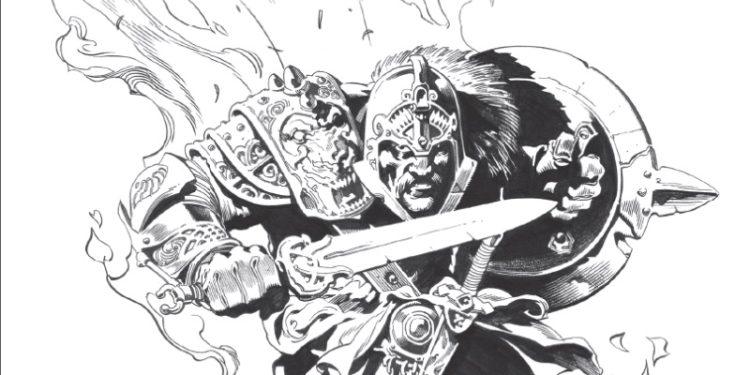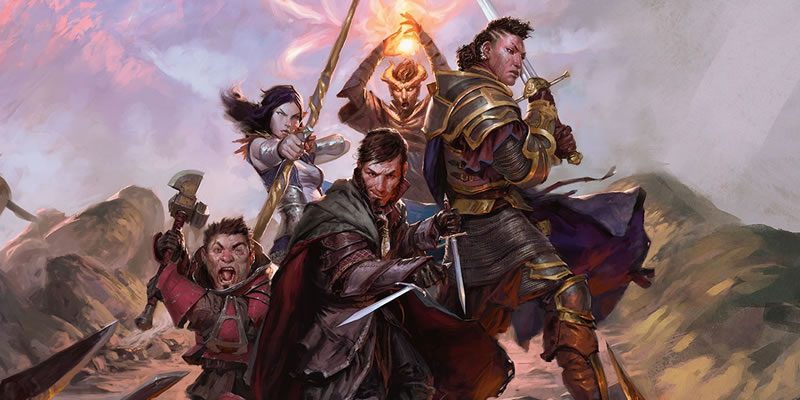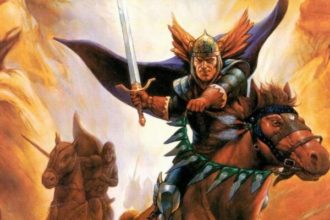The Fighter Class, Part One

I listened to your votes in the comments thread of my last article, and promptly ignored them when my wife voiced an opinion. Isn’t democracy great? So today we proceed with the History of the Fighter, which I anticipate to be one of the longest series in the whole of this column. If it passes the History of Domain Rulership, it’s gotten serious. That said, some individual iterations may be surprisingly brief, since the essence of early-edition fighters is simplicity.
Book I: Men & Magic
Since I’m not willing to dig back into Chainmail for this (sorry-not-sorry), we’re starting with Book I: Men & Magic from the original three-booklet set. Now, this is the first class I’ve covered from the original set – the only classes in evidence here are Fighting-Man, Magic-User, and Cleric – and the information presentation in this book is so tortured and first-draft-ish that I am absolutely going to miss important things.
So, first things first, this is the era of the game in which the class is called “Fighting-Man,” the term “fighter” or “warrior” being much too clear and simple. I’m sure it makes sense if Chainmail is all you know, but it looks like making an extra effort to be tone-deaf from the perspective of the early 90s (when I got my start), much less any later time.
- Fighting-Men receive more hit dice than other classes, starting with one extra hit point at 1st Now, understand that what we’re saying here is 1d6 + 1, +1 if their Con score is 15 or higher. This scales up more steeply than other classes, though like everything else it’s odd: sometimes a hit die receives a +1 bonus, only to have that +1 go away at the next level. People who care a lot more about this than I do have spent tons of time attempting to divine Gygax’s meaning here. Suffice it to say that a 10th-level fighter has 10d6 + 1 hit dice, +10 if their Con is 15 or higher.
- Of the three classes in Book I, Fighting-Men are the midrange XP class until you get to the jump from 6th to 7th. For reasons I cannot fathom, at that point they suddenly become the slowest class, and retain that position by a large margin from there on out.
- Fighting Capability – their base attack bonus, more or less – starts at “Man +1” and climbs to “Superhero +1” at 10th This absolutely means something if you are fluent in Chainmail.
- There’s an alternate combat system for people who don’t want to use Chainmail, which is a lot more like the combat matrices of 1e. You could, with modest effort, even convert it to an attack bonus progression, which I’ll do for the benefit of everyone who thinks in 3.x-and-later numbers. So a 1st-level Fighting-Man has an attack bonus of +1, which scales to +3 at 4th level, +6 at 7th level, +8 at 10th level, +10 at 13th level, and +13 at 16th level.
- Level Titles are totally a thing here, though there’s not a lot of discussion in this text as to what those titles mean in-setting. Anyway, what’s interesting about them is that once you’re a Lord (9th level and above), you have an optional secondary title, if and only if you build a castle. In that case, you become a Baron, which entitles you to collect rents from your tenants (10gp per head per year).
- As we’ll see, fighters continue to have a certain edge when it comes to the domain-rulership side game, buuuut in the original text, Clerics are laughing all the way to the bank on this one – they collect twice the rent that Fighting-Men do, they benefit from their church hierarchy matching their expenditures on their castle, and some of their soldiers are fanatics who serve for free.
- Hidden Features are totally a thing in the original three booklets! For example, nothing in the Fighting-Man writeup even hints that only Fighting-Men can hire Sages, nor does anything in Book III even hint as to why this should be so. I’m sure there are other things along these lines that I’m missing, but a fine-toothed comb and my available writing time have nothing in common.
- Magic Item Usage is a surprisingly huge part of each class’s features here. The three classes have sort of a Venn-diagram-like approach to itemization. Fighting-Men use weapons, presumably though not explicitly armor and shields, and very little else. Clerics can use blunt magic weapons, armor and shields, and lots of other kinds of items. Characters of other races also present special cases here. Anyway, since swords are much better and more varied than other magic weapons, including the exclusive capacity for Ego and the extra powers that go along with it, this feature actually matters.
- ETA: Also, Song of the Blade has done wildly better research than I have done, so instead of recapitulating it, I’mma just link it. This article spans Chainmail through 5e. Do read the comments on this one. Thanks to Tim Baker for pointing me toward this article.
- Strength is the Fighting-Man’s prime requisite, which means that they gain a percentage kicker to XP if their Strength scores are high. Strength does not otherwise do anything explicit in the rules.
- This changes in Supplement I: Greyhawk, which starts to blur a few lines on the fighter/Fighting-Man thing. Only Fighting-Men can gain Exceptional Strength as a result of having 18 Str. I’m not sure what the thinking was here, except that I read somewhere that Gygax thought fighters were and should be the best, but had released a game in which playing clerics or magic-users was simply more interesting, to say nothing of more powerful after the lowest levels of play. Strength starts to grant attack and damage bonuses at 13 or better, and scales up to quite sizable bonuses for 18/00 Strength. You can also achieve great feats of strength, like bending bars (ooh!) and lifting gates (ahh!). Carnival barker not included.
- The other big change in Supplement I is hit dice – instead of everyone using d6s, Fighting-Men get bumped up to d8s, as do all monsters.
- This decision interests me more than is really warranted: that instead of Fighting-Men being remarkable for their toughness, they remain on-par with the dangerous world around them, while the rest of the party is, in effect, pushed down. This is perfectly in keeping with the Fighting-Man as the quintessential Everyman, with no whiff of specialness about them. I’ve started to wish D&D would lean into the legendary toughness of fighters, embracing the fact that they survive things that kill the shit out of characters with d6s and d8s for Hit Dice. To those other folks, and especially to commoners, watching a fighter go should be about like watching a slasher in a horror movie. They’re on your side, but… why is that dude still standing, this is not okay.
There isn’t any visible theme here, beyond The Everyman Who Becomes a Hero, but the Fighting-Man is deliberately the simplest class in the game to play. Even if you aren’t bad at picking names, picking a name might still be the slowest part of character creation, because choosing Fighting-Man is literally your only other choice point unless you decide to get fancy with the 2:1 or 3:1 ability score tradeoff business. (Don’t do it, it’s a bad deal if your DM eventually opens the door to Supplement I.) Spoiler, over the course of the next 43 years, the fighter is still going to be the quintessential Everyman, though you’ll increasingly be free to bolt on theme in one way or another. The point at which the tabula is no longer rasa moves around a bit from edition to edition; in the original books, I’d argue that that happens at 9th level.
The text does explicitly call out that Magic-Users are very weak at low levels, but become powerful later as long as their Fighting-Men friends protect them. Magic-Users are what MOBA players call a Carry class, while Fighting-Men grow up to discover that they really were just grogs all along.
Rules Cyclopedia
Well, right off the bat, this class is named Fighter, so that’s different. Mechanically, the differences are superficially slim, but really they’re just well-hidden in the text outside of the class writeup itself.
- Weapon type offers actual variation, so it makes a bigger difference that you can use any weapon. There’s a whole chart of weapons, and in the text description that follows we find many of our old friends like the spontoon, the bill, and the partizan (favored by Hamlet scholars everywhere).
- At 1st level, fighters learn two maneuvers: Lance Attack and Set Spear vs. Charge. These work about like you think, doubling the dice of the damage roll when you do the thing.
- At 9th level, fighters can Smash, Parry, and Disarm.
- Smash is an early-edition Power Attack: you lose initiative for the round and take a -5 to hit, but add your Strength score to your damage total.
- Parry sacrifices all of your attacks for the round to impose a -4 penalty to all enemy attacks against you.
- Disarm does what it says on the tin, but the mechanics are a bit awkward – after you hit with an attack, you declare that you want to Disarm them. You do no damage. The victim rolls 1d20 + your Dex bonus – their Dex bonus. If the result is greater than their Dex score, congratulations! You have Disarmed them until their next action.
- At 12th level, fighters can make multiple attacks if it is trivially easy for them to hit their opponent. If they would hit their target on a natural 2, they make a second attack against that same target. This increases to a third attack at 24th level and a fourth attack at 36th level (RC’s level cap for human fighters).
- Weapon Choice slots, which have everything in common with 2e-style Weapon Proficiency slots, show up here. Fighters, unsurprisingly, get more of these than anyone else, though in principle everyone could work their way up to Grand Mastery with a weapon. The actual, five-tiered system of weapon skill is a little more than I am up for covering in this article; suffice it to say that it is super involved, lends a ton of distinctiveness to each weapon, and the difference between a fighter using this system and one ignoring it is about on par with a 3.x fighter with feats and one without.
- Back when I wrote about paladins in the Rules Cyclopedia, I explained that paladins and avengers were both outgrowths from the fighter. Go read that, if you haven’t or if you need a refresher course.
- The combat matrices of RC cannot be converted cleanly into an attack bonus progression, because of some oddities. Fighters start off at the same level of worthlessness as everyone else, but improve earlier (4th level rather than 5th or 6th, woo!) and climb a little higher than other classes.
This doesn’t exactly bring us to the end of the OD&D fighter class, but that’s as many versions as I’m covering within OD&D. For that matter, there might also be a dozen more feature buried in the Rules Cyclopedia that I am not spotting. I think there’s something with how fighters become Immortals? Outside the scope of this article, in any case. The apparent trend-line is – of course – increasing complexity and options, though Rules Cyclopedia pushes most of those options off until you’ve had plenty of time to familiarize yourself with the fighter’s game loop and you’re ready for a shakeup. (Or it’s that thing that is forever out of reach, because 8th level takes a ton of experience points.) It’s kind of interesting that you start to branch out with combat options one level before the whole campaign potentially shifts into domain rulership or paladinhood or whatever other major shift happens at the all-important 9th (Name) level. It suggests that games really ought to reach such levels quickly, since there are still 28 more levels of play to experience. I always wonder how people used BECMI and the Rules Cyclopedia – did they almost exclusively play games that ended around 5th or 6th level, as the OSR community seems to suggest, or were they (likely teenagers at the time) racing onward to ever greater character levels, since TSR went to the trouble of creating them?
Next time, we’ll move on to AD&D 1e and UA. I suspect there are plenty of Dragon Magazine articles that offer variant Fighting-Men or fighters, so by all means point them out to me.



